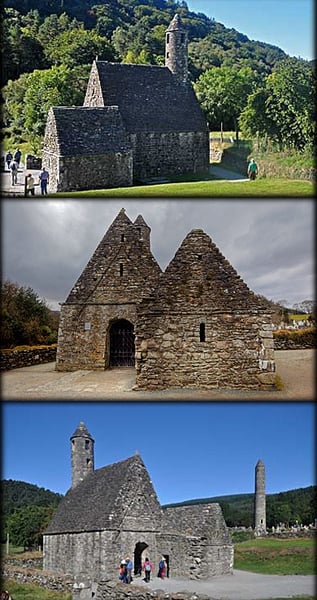The Life of St. Kevin
Born in 498, St. Kevin, or Caoimhín in Irish, lived a long and impactful life, passing away in 618. A scion of noble Leinster lineage, he became a hermit, ascetic, and a great standard bearer for the unique spiritual beauty of Celtic Orthodoxy. He was baptised by St. Cronan of Roscrea. Roscrea, a bustling village in County Tipperary in the West of Ireland, remains one of the oldest continuously inhabited settlements on the island. Having studied for the priesthood under the tutelage of three holy men – Eoghan, Lochan, and Eanna – from the age of twelve, he was eventually ordained by Bishop Lugidus and then sought the solitude of the wilderness.
His holiness profoundly impacted those around him early in his life, drawing others to seek his guidance. Although Kevin, like many great saints, yearned for solitude and a life of ascesis and prayer, he retreated to a place of rugged beauty known as Glendalough, which literally means "Valley of two lakes". In that era, this secluded valley offered the perfect environment for profound contemplation and the spiritual battles that anchor the lives of the devout.
As there were no buildings in that remote time, church tradition tells us that an angel guided him to a remarkably narrow cave with a low ceiling, barely sufficient for sleep. To this day, this humble dwelling persists and is known as Kevin's Bed. Winters in this region are notoriously harsh; the temperate but humid Irish climate lends a penetrating cold that settles deep within the bones. Yet, for Kevin, this austere environment was precisely what his soul yearned for – an unhindered communion with Christ.
The cave can still be visited, though the path is perilous, often leaving visitors to Glendalough content with a distant view from across the lake. However, for the brave and when the weather permits, the cave proper can be reached. An interesting anecdote from more recent Irish history tells of an Irish rebel, pursued by British soldiers through the area, who sought refuge in St. Kevin's Bed after swimming across the lake. The cave offered him sanctuary, and he safely evaded the searching British forces.
During those early years of intense prayer, a remarkable miracle occurred, demonstrating St. Kevin's profound connection with the divine. One time, a black bird landed in St. Kevin's outstretched hand as he was deep in prayer. This would not have been unusual, as Glendalough in those times teemed with wildlife, and St. Kevin is fondly remembered in Ireland for his affinity with these creatures and the natural world. Unperturbed, St. Kevin remained so deeply absorbed in prayer that the bird built its nest in his hand. Throughout this entire event, St. Kevin never moved, and only when the bird had finished with its use of the nest and had flown away permanently did he stir. This extraordinary display of spiritual endurance became one of the many reasons people were drawn to St. Kevin's holiness.
Beyond his tender companionship with the animals of Glendalough, Kevin embraced an extreme form of asceticism: walking barefoot, sleeping on stones, subsisting on nettles and herbs, clad only in animal skins, and dedicating his days to profound prayer. Such rigorous practices were a testament to his unwavering dedication to Christ and the mortification of earthly desires.
He would often stand in the icy waters of the lake, maintaining vigil and reciting psalms. Church tradition recounts another wondrous event: while standing in the cold waters, his psalter slipped from his grasp and sank into the depths. Yet, by divine grace, an otter retrieved it, returning the sacred book to him unharmed.
On another occasion, a young man afflicted with epilepsy received a vision that he would be cured by eating an apple. However, the monastic grounds lacked any apple trees. Upon hearing of this, St. Kevin, through the power of his unwavering faith and fervent prayer, commanded a willow tree to produce apples, and miraculously, it did. The boy ate an apple and was healed of his ailment.
After years spent in the solitary embrace of the wilderness, the growing number of his disciples established a settlement in the area known as Kevin's Cell. Yet, his deep yearning for solitude remained, prompting him to retreat further into the wild for another four years. Eventually, however, he returned to the monastery in Glendalough, which stands to this day, and dedicated the remainder of his earthly life to prayer, fasting, and guiding his followers. During this time, Glendalough flourished, becoming a renowned seminary of saints and scholars.
Glendalough continued to flourish for many centuries beyond his death, evolving into one of the most important monastic centres in Ireland. It was celebrated not only as a sanctuary of profound spirituality and rigorous asceticism but also as a significant center of learning. Monks there excelled in various arts and sciences, including the intricate craft of manuscript illumination, and the diligent study of Scripture and classical texts. Pilgrims journeyed to Glendalough from across Ireland and even distant lands, seeking spiritual blessings and healing at the sacred site founded by St. Kevin.
St. Kevin of Glendalough,
pray for us!




Within Glendalough, the remains of a church known as St. Kevin's Kitchen still stand. The moniker "kitchen" derives from the church's distinctive shape (as depicted below). A rectangular structure crowned with a round belfry was an architectural anomaly in that era. This church is believed to have been erected either by St. Kevin himself or by his devoted followers shortly after his blessed repose.
St. Kevin was a true soldier of Christ in the land of Ireland and remains a radiant beacon of asceticism and prayer for Orthodox Christians worldwide.